The most common problem of the spine is osteonecrosis. This disease can affect every part of the spine, which is subject to increasing stress. It manifests at any age, usually the older generation falls into the risk group. Symptoms of osteonecrosis of the thoracic spine increase with an acute pain.
What is a woman's thoracic spondylitis?
This disease is characterized by dystrophic and degenerative disorders of the spine, changes in the structure and shape of the discs. Osteoarthritis of the thoracic spine progresses by the age of 40, and many patients have to carry it on their feet. This cannot be done, because over time the intercostal nerves are compressed; Disability is not excluded. The upper thoracic vertebrae are involved in the pathological process, the patient is diagnosed by the characteristic chest pain.
Symptoms of osteonecrosis of the breast in women
The point is to define the disease of the sexes more equally, since its symptoms are similar to the manifestations of other pathological conditions of the female body. For example, an acute pain in the peritoneal region may be the cause of damage to the mammary glands, or it may become the result of a heart attack or angina. To refute or confirm your speculation, you need to take heart medication. A lack of positive energy indicates a healthy heart and obvious problems with the spine.
Some patients believe that chronic gastritis or duodenal ulcer is the cause of the pain. In fact, these are hallmarks of fibrocystic breast disease in women, which only increase over time, become more intense, long-lasting. The diagnosis can be confused with shingles, as the pain can be localized to the same area. To accurately distinguish the disease, the characteristics of some symptoms are not enough; requires an integrated approach to an evolving problem.

Symptoms of thoracic osteonecrosis in men
The disease can develop in the male body, especially if you adhere to a sedentary lifestyle, choosing heavy physical work for yourself. Signs of thoracic osteosarcoma in men can be confused with acute pleurisy, angina attacks, scoliosis, cholecystitis, and other cardiomyopathies. You can be sure that this is not a heart attack caused by medication, but only the attending physician will prescribe heart medication. Superficial self-medication is completely excluded. With this disease, not only chest pain, but also other symptoms:
- foot numbness;
- crawl on the skin;
- increased muscle tension;
- symptoms of decreased potency;
- low back pain in the interstitial region.
How does thoracic osteonecrosis manifest?
The disease begins with an acute pain localized in the chest, resembling a heart attack. At first, pain was observed when turning, leaning, and breathing deeply. Over time, back pain reminds itself even during periods of rest. Since the focus of the pathology is localized in the upper chest, complications if not adequately treated are observed involving the myocardium, affecting the cardiovascular system. In addition, osteonecrosis of the chest is manifested by the following neurological symptoms:
- cow feet;
- muscle tension reflexes of the back and chest;
- dysfunction of the pelvic organs;
- numbness in the abdomen and above the sternum;
- pain that gets worse with moderate exercise.
How to destroy painful chest bone
Not all patients know what osteonecrosis of the chest looks like - the symptoms don't remind themselves for a while. The location of the lesion can be determined clinically, but the patient must first consult a specialist when presenting with back pain or low back pain between the shoulder blades. If they are not treated in time, the symptoms of a specific disease only develop, getting worse and worse. Pain in the chest with osteonecrosis has different characteristics, depending on the degree of the pathological process and the specifics of the organism.

Exacerbation of osteonecrosis of the chest
If the trunk remains in a sitting position for a long time, with progressive osteonecrosis, the occurrence of back pain is not excluded. This is an acute pain that can spread to the cervical and lumbar spine, and at the same time disrupts breathing and paralyzes the patient's movements. An exacerbation of thoracic osteonecrosis begins only with severe pain in the left and right side of the sternum, which is difficult to stop with medication. Such a state cannot be simulated, as it confuses the patient with the bed, causing him to lose sleep and rest.
If we talk about the increasing symptoms of back pain, then this sign of thoracic osteonecrosis develops later. It appears in the hypochondrium, but before that it develops imperceptibly for 2-3 weeks. Extensive damage to the intercostal spaces begins with general discomfort when the body's position is changed, then is replaced by dangerous pain in the costal region. Among the complications, doctors distinguish cholecystitis and shingles.
Attacks of thoracic osteonecrosis
With such an unpleasant disease, nerve fibers are affected, so an attack is always accompanied by acute pain, at an early stage of development, localized of unknown etiology. At first, unpleasant sensations are observed with sudden movements, in the case of increased activity, coughing and sneezing, but then specific symptoms remind themselves even at night, whenThe body is relaxed and rested.
Do not rule out frequent abdominal pain, when acute pain is concentrated in the front of the chest, not allowing inhalation and exhalation, literally paralyzing the whole body, disrupting the rhythm of daily life. Without timely treatment, the pain caused by osteonecrosis of the thoracic region only increases, rendering a once healthy person useless.

Symptoms of advanced osteonecrosis
Severe disease leads to displacement of the discs, disrupting the shape and structure of the spine. For patients, this is an acute pain that does not allow turning, limiting movement and physical activity, which is one of the main causes of emotional instability. During the pathological process, systemic circulation is disrupted, and the progressive symptoms of progressive osteonecrosis lead to the following health complications:
- myocardial dystrophy;
- renal dysfunction;
- disc herniation;
- symptoms of decreased potency;
- roofing sheets;
- dystrophy of other parts of the spine;
- extensive damage of internal organs.

















































